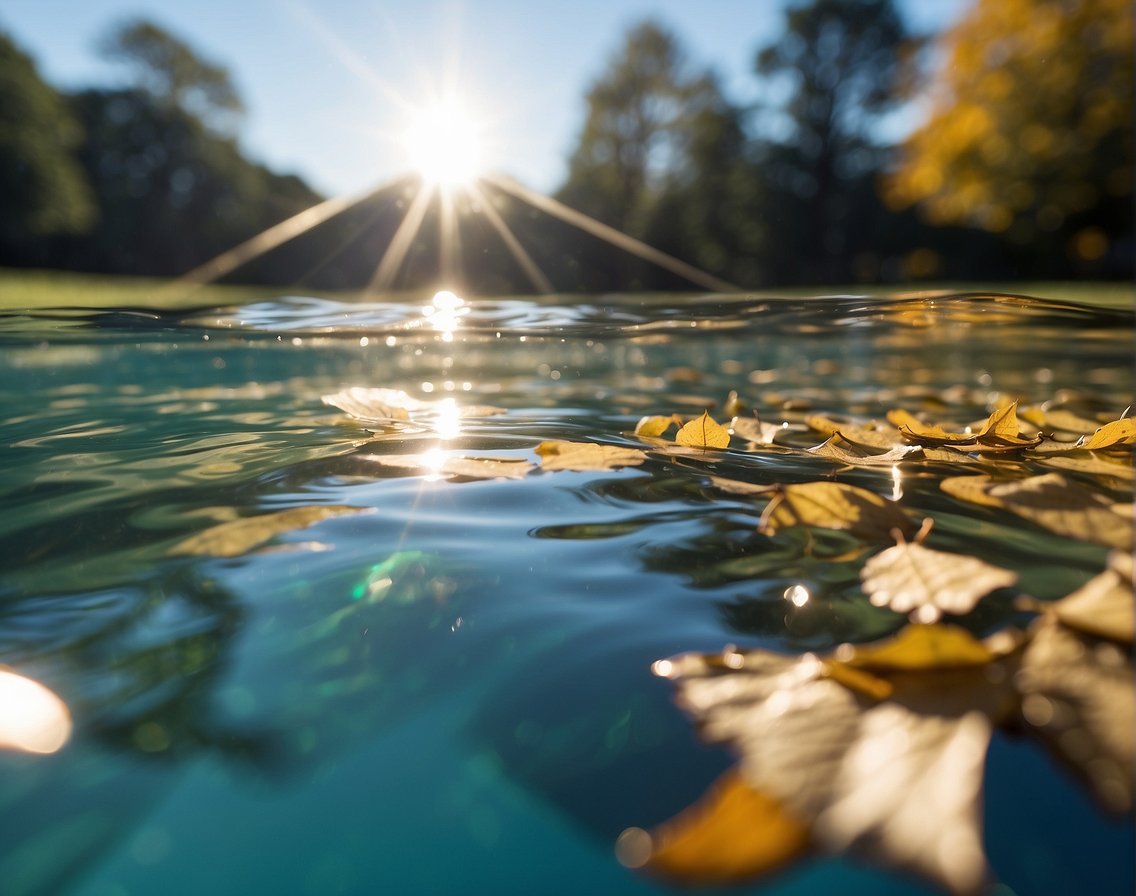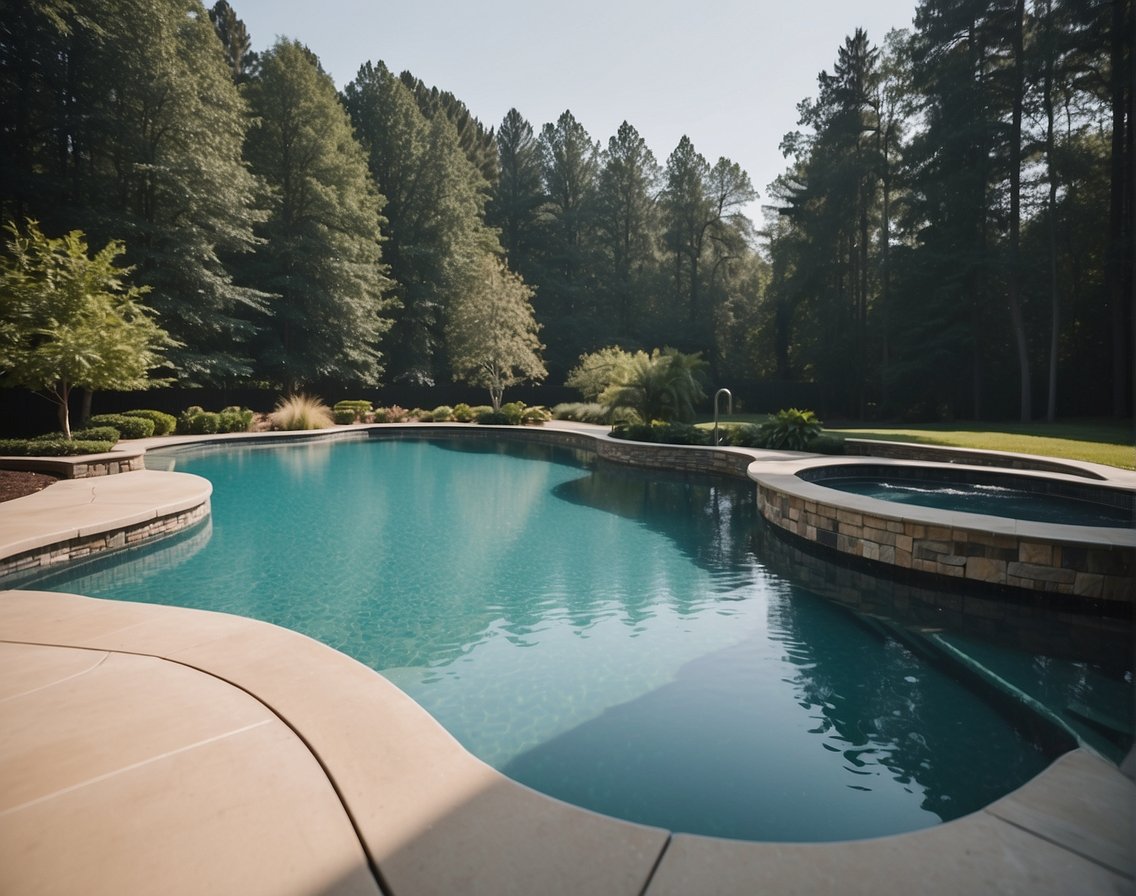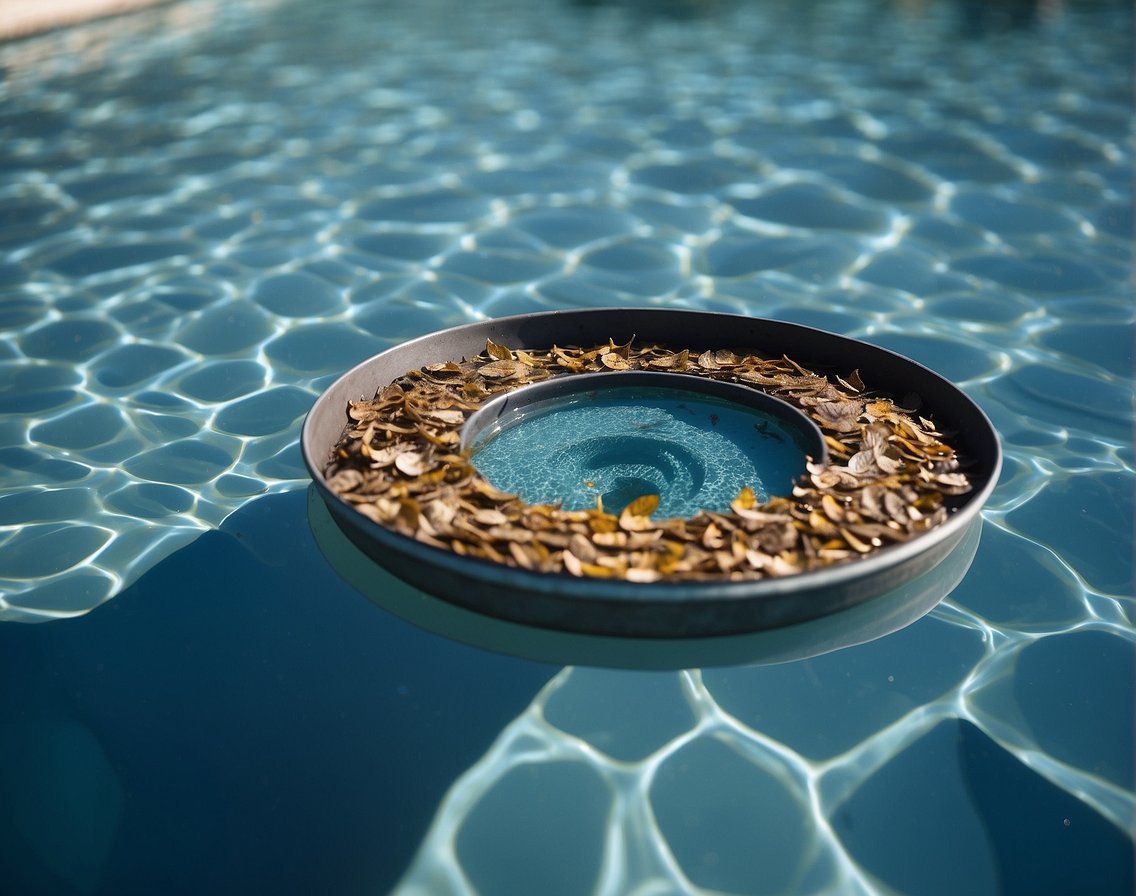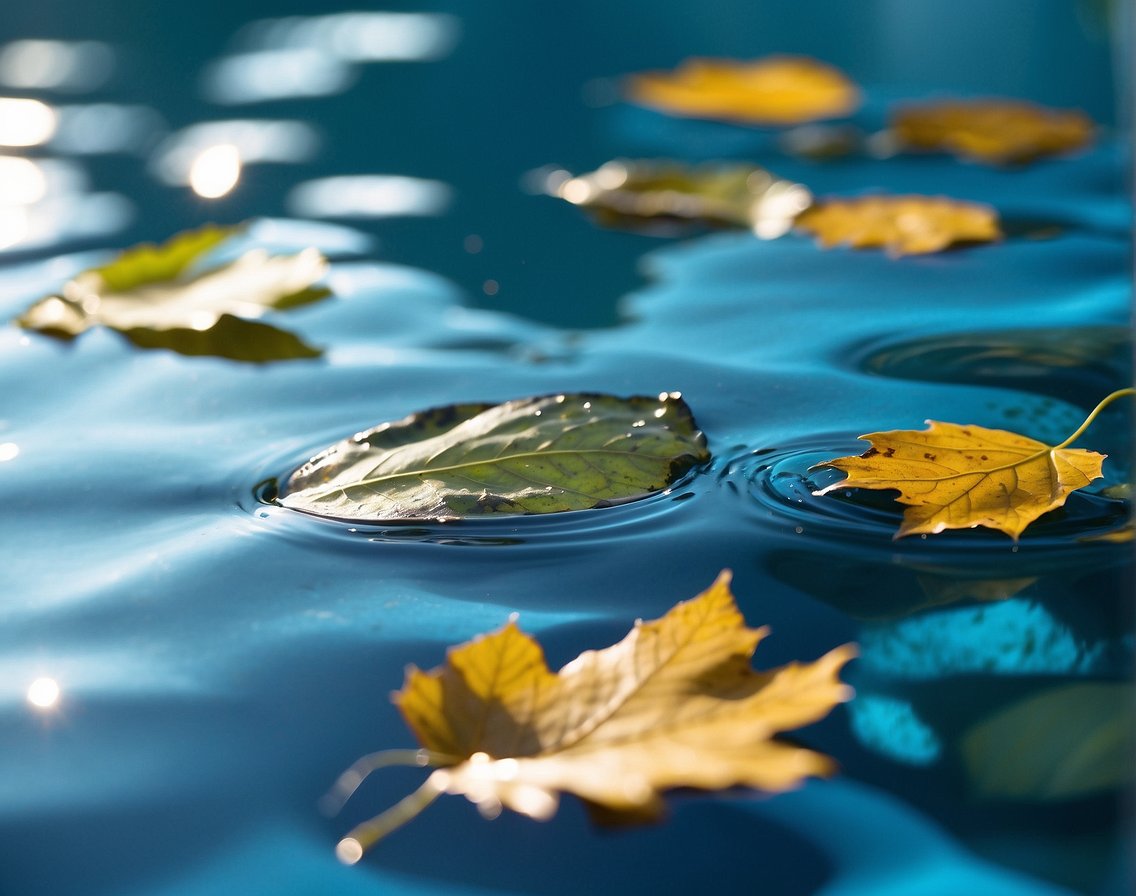Understanding Pool Skimming Essentials

Effective skimming is crucial in maintaining a swimming pool’s health and aesthetic appeal. We ensure that surface debris is consistently removed to prevent contamination and maintain water quality.
The Role of Skimming in Pool Maintenance
Skimming is a fundamental maintenance task for any swimming pool. By removing debris such as leaves, insects, and other floating objects, we prevent them from sinking and decomposing, which can lead to algae growth and poor water quality. A routine skimming schedule is key to preserving the pool’s cleanliness and ensuring the filtration system operates efficiently.
Types of Skimmers and Their Functions
Pool skimming can be performed using different types of skimmers. The primary types we’ll discuss are the skimmer basket and automatic skimmer.
Skimmer Basket:
- Function: Traps larger debris before it reaches the filter
- Location: Fixed into the side of the pool
- Maintenance: Regular emptying to maintain skimming efficiency
Automatic Skimmer:
- Function: Moves around the pool to collect debris, operating independently of the pool’s filtration system
- Type: Often solar-powered or connected to the pool’s pump system
A skimmer net may be used as a manual tool to complement these devices, providing us with a way to capture any excess debris missed by the primary skimming mechanisms.
Proper Skimming Techniques

To keep your pool pristine, we’ll focus on mastering manual skimming, utilizing automatic pool cleaners, and maintaining skimming equipment for long-lasting use.
Manual Skimming Procedures
When manually skimming a pool, it’s essential to use a flat skimmer attached to a telescopic pole. First, ensure the skimmer net is securely fastened to the telescope pole. Use long, steady strokes to move across the water surface, pushing debris towards the edge for easier collection. Here are some points we follow:
- Begin at the pool’s far end, moving towards the opposite side to prevent re-circulating debris.
- Overlap each stroke slightly to ensure no debris is missed.
- Angle the skimmer slightly forward to trap larger debris effectively.
Using Automatic Pool Cleaners
Automatic pool cleaners simplify our pool maintenance significantly. Here’s how we use them:
Robotic pool vacuums:
- Plug in the cleaner and ensure it’s properly charged or connected to a power source.
- Place it in the pool, allowing it to methodically clean the surface and floor.
Suction-side pool vacuums:
- Connect the vacuum to the intake side of the pool’s pump.
- Move the vacuum across the pool, much like you would with a manual vacuum.
Maintaining Your Skimming Equipment
Proper maintenance of your pool skimming equipment ensures its longevity and efficiency.
- Manual skims and telescopic poles:
- Regularly inspect nets for holes and poles for rust or damage.
- Clean the netting with fresh water and allow it to air dry after each use.
- Automatic pool cleaners:
- Check and clean out filters or collection bags as part of your routine.
- Store the equipment in a cool, dry place to prevent weathering and wear.
Optimizing Your Filtration System

To ensure your pool remains clean and clear, it is crucial that we keep our filtration system operating at its best. The health of your Georgia pool is dependent on an effective filtration system, which requires regular maintenance and understanding of its components.
The Importance of a Clean Filter
A clean filter is the heart of a pool’s filtration system, trapping debris and preventing contaminants from circulating back into the water. To operate efficiently, the filter should be free of obstructions, allowing smooth water flow and optimal pressure levels. It is recommended that we check the filter’s condition every month during peak usage.
- Cartridge Filters: Clean when pressure reaches 8-10 psi above normal.
- Sand Filters: Clean when pressure increases by 6-8 psi.
- Diatomaceous Earth (DE) Filters: Clean when pressure rises by 8-10 psi.
Regular cleaning is not only about maintaining water quality but also about preserving the longevity of the filter itself.
Regular Backwashing and Inspection
Backwashing reverses the flow of water through the filter to remove any trapped dirt and debris, a necessary step for maintaining our pool’s filtration. Depending on the type of filter and the amount of pool use, we’ll likely need to backwash:
- Sand and DE Filters: Every 1-2 weeks during high usage or after heavy loads, such as parties or storms.
- After Vacuuming: Always a good practice to backwash if vacuuming significantly increases pressure.
In addition to backwashing, we should perform a thorough inspection of the entire filtration system, including the pump and pump strainer basket, to ensure all parts are functioning correctly and there are no leaks or damages.
Addressing Common Filtration Issues
When addressing filtration issues, staying ahead of potential problems is crucial for us. Here are some common challenges and how we manage them:
- High Pressure: Indicates a clogged filter; we should clean or backwash it.
- Low Pressure: Suggests a blockage or leak in the suction side of the pump or a worn pump impeller.
- Poor Water Circulation: Could be the result of a too-small pump or clogged impeller.
By proactively managing these issues, we ensure optimal filtration, reduce strain on our pool pump, and maintain excellent water clarity for our Georgia pool.
Maintaining Pool Water Quality

We must ensure the pool water is both inviting and safe for swimmers by regularly checking water chemistry, preventing contaminant growth, and understanding the health implications of a clean pool.
Balancing Water Chemistry
Proper water chemistry is essential for maintaining a healthy swimming pool. pH levels should be kept between 7.2 and 7.8 to prevent irritation and protect the pool equipment. Total alkalinity, which stabilizes pH, should be maintained between 80 to 120 ppm. Calcium hardness should be in the range of 200 to 400 ppm to prevent plaster damage. Regularly testing and adjusting these levels is crucial for optimal water balance.
- Chlorine, a primary disinfectant, should be consistently maintained:
- Ideal chlorine level: 1-3 ppm
- Free Chlorine: Kills pathogens
- Combined Chlorine: Indicates sanitizer effectiveness
Preventing Algae and Bacteria Growth
Algae and bacteria pose significant threats to pool water quality. We can prevent their growth by maintaining suitable chlorine levels and keeping the water chemistry balanced. It’s important to prevent these contaminants, as they can lead to unhealthy swimming conditions and can also damage the pool surface.
Strategies to Prevent Contaminant Growth:
- Use algaecides as needed.
- Regularly brush and vacuum the pool.
- Maintain proper water circulation.
Health Benefits of Clean Swimming Pool
A clean swimming pool offers numerous health benefits. It reduces the risk of waterborne diseases and ensures a safer swimming environment. Well-maintained water can prevent skin and eye irritation and helps in promoting overall wellness.
Impacts of Clean Pool Water on Health:
- Decreases the potential for bacterial and algae-related illnesses.
- Provides a safe and enjoyable swimming experience.
Seasonal Pool Care and Troubleshooting

As we navigate the varying seasons in Georgia, it’s imperative we adapt our pool care tactics to address the challenges brought by storms, seasonal changes, and mechanical issues.
Dealing with Storms and Natural Debris
In the wake of storms, our pools often become receptacles for falling leaves, sticks, and floating debris. It’s crucial to remove these elements promptly to prevent clogging of the pool’s filtration system. We recommend the following steps:
- Skim the surface: Use a leaf skimmer to remove floating debris, such as leaves, bugs, and sticks.
- Clean the pool floor: Utilize a pool vacuum or automatic pool cleaner to address debris on the bottom.
- Check and clear baskets: Empty the skimmer and pump baskets regularly to ensure optimal water flow.
Pro Tip: Trim trees and bushes around the pool area to reduce the amount of natural debris blown into the pool by strong winds.
Winterizing and Pool Opening Best Practices
Winterizing our pools is vital to protect them during colder months, and proper opening procedures ensure a clean and safe pool for the warmer seasons.
Winterizing
- Balance water chemistry prior to closing to protect against corrosion and scale.
- Install a winter cover to keep out debris and maintain water levels.
Opening:
- Remove the winter cover carefully to avoid spilling debris into the pool.
- Rebalance water chemistry and run the pump for at least 24 hours.
We should consult with a pool professional to ensure we are using the correct winterizing chemicals and techniques specific to our pool type and climate.
Troubleshooting Skimmer and Pump Issues
If we encounter issues with our skimmer and pump, it’s often due to clogs or wear on parts like the o-ring or weir. Here’s our approach:
- Check the weir: Ensure it functions properly; it should move freely to trap debris and regulate water flow.
- Inspect the suction hole: Confirm that it is not obstructed by debris, which could reduce the skimmer’s effectiveness.
Common Issues and Solutions:
- For reduced suction, we often find it is an issue with the o-ring. Regularly lubricate and check for wear and replace it if necessary.
- If the pump is not priming, we should ensure all valves are open and the pump basket is not cracked or damaged.
Engaging a pool cleaning service for regular maintenance can help prevent most of these issues and ensure our pool system runs smoothly throughout the year.
Frequently Asked Questions
In this section, we cover the essentials of skimming your pool efficiently in Georgia’s unique conditions.
What is the most efficient method for skimming a pool in varying weather conditions?
To address varying weather, we suggest using a wide-mouthed, deep net attached to a telescopic pole for windy days, which can gather more debris, and a flatter, finer mesh skimmer after a rain to capture small particles.
How often should you skim your pool in Georgia climates to maintain cleanliness?
Skimming daily is ideal to prevent debris from sinking and potentially causing algae growth, which is enhanced by Georgia’s warm temperatures and high humidity, especially in summer.
What features should you look for in a pool skimmer to handle common debris in Georgia?
The ideal pool skimmer for Georgia’s common debris—like leaves, pollen, and bugs—would have a sturdy frame, a fine mesh basket for small particles, and compatibility with your pool’s size and pump system.
When is the best time of day to skim your pool for optimal maintenance?
Skimming your pool in the early morning or evening helps avoid the heat of the day, making it easier for you and less stress on the equipment. This also prevents debris from settling overnight.
Can solar pool skimmers effectively maintain a clean pool surface in Georgia?
Yes, solar pool skimmers can be effective in Georgia’s sunny climate; they continuously remove debris and reduce the workload on your filter system, which can be especially beneficial during long sunny days.
What is the proper placement of skimmers to ensure comprehensive pool surface cleaning?
For comprehensive cleaning, place skimmers opposite the return jets to create a circular flow that pushes debris towards them, and consider the prevailing wind direction to position additional skimmers downwind.
